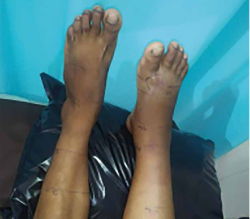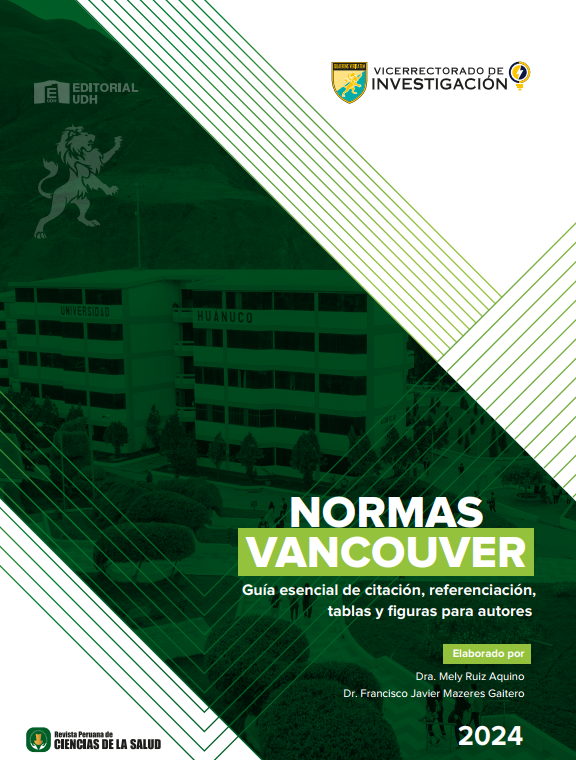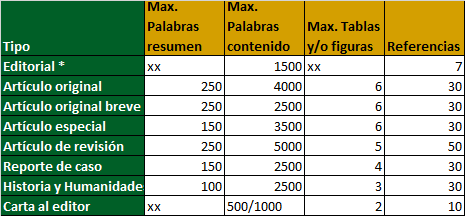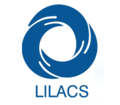Clinical management and treatment of snakebite accidents in a hospital in Bolivia
DOI:
https://doi.org/10.37711/rpcs.2024.7.1.558Keywords:
snakes, hemolytics, gingival hemorrhage, poisoning, antivenomAbstract
Objective: To analyze the initial clinical management of patients with snakebites in a hospital in Bolivia. Methods: A quantitative, descriptive, and retrospective study was conducted at the Hospital San Francisco de Asís in Villa Tunari, Cochabamba. A total of 144 medical records of patients diagnosed with snake venom poisoning between January 1, 2022, and June 30, 2023, were included. Data on age, gender, signs and symptoms, type of snake, use of a tourniquet, antivenom, antibiotics, analgesics, and length of hospital stay were collected. Descriptive analysis was used to evaluate the data. Results: Most patients were women (51 %) with an adult age range (27 to 59 years). A tourniquet was applied in 9.7% of the cases. The predominant signs and symptoms were pain (90 %) and edema (70 %). Tramadol was the most commonly used analgesic (39 %) and cloxacillin the most frequently used antibiotic (45 %). The BothropsLachesis Antivenom was administered in 62% of the cases. Sixty percent of patients did not experience complications, and the average length of hospital stay was 4 days. Conclusions: This study highlights the importance of standardized and timely clinical management in snakebite cases, emphasizing the correct identification of the venom, pain management, rational use of antibiotics, and proper administration of the specifc antivenom.
Downloads
References
Maldonado Molina AS, Minga Jiménez NM. Actualización de la conducta clínica, diagnóstica y terapéutica en los accidentes ofídicos [Internet]. Riobamba: Universidad Nacional de Chimborazo; 2024 [Consultado el 15 marzo de 2024]. Disponible en: http://dspace.unach.edu.ec/handle/51000/13459
Rey Pardo CD, Romero Meléndez B. Evaluación del riesgo biológico por ofídicos en los trabajadores operarios del condominio Entre Puentes del municipio de Apulo Cundinamarca [Internet]. Bogotá: Corporación Universitaria Minuto de Dios; 2024 [Consultado el 15 marzo de 2024]. Disponible en: https://repository.uniminuto.edu/items/02e0e858-331a-4420-a2ff-bf8e9c6ecb1c
Kasturiratne A, Wickremasinghe AR, de Silva N, Gunawardena NK, Pathmeswaran A, Premaratna R, Savioli L, Lalloo DG, de Silva HJ. The Global Burden of Snakebite: A Literature Analysis and Modelling Based on Regional Estimates of Envenoming and Deaths. PLoS. Med. [Internet]. 2008 [Consultado el 15 marzo de 2024];5(11):e218. doi: 10.1371/journal.pmed.0050218
Gutiérrez JM. Envenenamientos por mordeduras de serpientes en América Latina y el Caribe: Una visión integral de carácter regional. Bol. Mal. Salud Amb. [Internet]. 2011 [Consultado el 15 de marzo de 2024];51(1):1-16. Disponible en: http://ve.scielo.org/scielo.php?script=sci_arttext&pid=S1690-46482011000100001&lng=es
Silva MB, Costa CD, Moreira J. Perfl de los accidentes por mordeduras de serpiente en un estado de Brasil: Un análisis retrospectivo. Rev. Bras. Ter Intensiva [Internet]. 2020 [Consultado el 10 de abril de 2024];32(4):385-91. https://doi.org/10.1590/S1980-220X2020007003721
Instituto Biológico Argentino. Suero Antiofídico Polivalente BIOL [Internet]. Buenos Aires: S.A.I.C.; 2006 [Consultado el 4 de abril de 2025]. Disponible en: https://biol.com.ar/descargas/Tarjeton-Suero-Antiofdico.pdf
Rodríguez Canseco JM, Arnaud Franco A, Gutiérrez López E, Romero Figueroa G. Panorama epidemiológico de las mordeduras por serpientes en la península de Baja California, México (2003-2018). Rev. Mex. Salud Pública [Internet]. 2021 [Consultado el 22 de enero de 2024];63(Supl1):S79-S87. Disponible en: https://www.scielo.org.mx/pdf/gmm/v157n6/0016-3813-gmm-157-6-579.pdf
Instituto Nacional de Laboratorios de Salud. Innovación científica: sueros y antídotos made in Bolivia’ [Internet]. La Paz: INLASA; 2024 [Consultado el 5 de febrero de 2024]. Disponible en: https://www.inlasa.gob.bo/2024/06/innovacion-cientifica%E2%80%88sueros-y-antidotos-made-in-bolivia
Silva MB, Costa CD, Moreira J. Perfl de los accidentes por mordeduras de serpiente en un estado de Brasil: Un análisis retrospectivo. Rev. Bras. Ter. Intensiva [Internet]. 2020 [Consultado el 10 de abril de 2024];32(4):385-91. https://doi.org/10.1590/S1980-220X2020007003721
Príncipe Azevedo LR, da Cruz Rodrigues K, Rodrigues Macedo VP, Arruda de Faria C. Perfl clínico-epidemiológico dos acidentes ofídicos ocorridos no Brasil. SaudColetiv. (Barueri) [Internet]; 2021 [Consultado el 4 de abril de 2025];11(61):4876-87. https://doi.org/10.36489/saudecoletiva.2021v11i61p4876-4887
Lopes Gomes JN. Accidente ofídico en el Magdalena Caldense: Análisis epidemiológico y factores de riesgo [Internet]. Manizales: Universidad de Caldas; 2024 [Consultado el 4 de abril de 2025]. Disponible en: https://repositorio.ucaldas.edu.co/handle/ucaldas/20020
Vieira DS, Soares ALBR, Arbs FC, Martins ML, Côrtes PPR. Análise epidemiológica de acidentes ofídicos no município de Vassouras, RJ: estudo retrospectivo. Ver Pró-UniverSUS. [Internet]. 2019 [Consultado el 19 de marzo de 2025];10(2):08-12. Disponible en: https://doi.org/10.21727/rpu.v10i2.1896
Rita TS, Sisenando HA, Machado C. Análise epidemiológica dos acidentes ofídicos no município de Teresópolis-RJ no período de 2007 a 2010. Rev. Ciência Plural [Internet]. 2016 [Consultado el 4 de abril del 2025];2(2):28-41. https://doi.org/10.21680/2446-7286.2016v2n2ID9639
Rojas CA, Gonçalves MR, Almeida-Santos S. Epidemiologia dos acidentes ofídicos na região noroeste do estado de São Paulo, Brasil. Rev. Bras. Saúde Prod. Anim. [Internet]. 2007 [Consultado el 4 de abril de 2025];3(8):193-204. https://www.cabidigitallibrary.org/doi/pdf/10.5555/20093272342
Lima JS, Júnior HM, Martelli DRB, Silva MS, Carvalho SFG, Canela JR, et al. Perfil dos acidentes ofídicos no norte do Estado de Minas Gerais, Brasil. Rev. Soc. Bras. Med. Trop. [Internet]. 2009 [Consultado el 4 de abril de 2025];42(5):561-4. https://doi.org/10.1590/S0037-86822009000500015
Sangenia LHC, Lima LS, Leite GR, Calheiros VS, Rocha NS, Nielebock MAP. Acidentes ofídicos no município de Valença, Rio de Janeiro: possível emergência de envenenamentos por cascavel. Rev. Patol. Trop. [Internet]. 2013 [Consultado el 4 de abril de 2025];1(42):114-20. https://doi.org/10.5216/rpt.v42i1.23589
Ávila L, Pavan CH, Biscoglio MJ, Dokmetjian JC, Cascone O, Fingermann M. Variabilidad de la composición proteica del veneno de Bothrops alternatus de Argentina y su posible relación con la actividad biológica. Ver. Farm. [Internet]. 2018 [Consultado e 12 de febrero de 2024];160(1):19-27. Disponible en: https://ri.conicet.gov.ar/handle/11336/86985
Gutiérrez JM. Envenenamientos por mordeduras de serpientes en América Latina y el Caribe: Una visión integral de carácter regional. Bol. Malariol Salud Ambient. [Internet]. 2011 [Consultado el 7 de marzo de 2024]51(1):1-16.
Disponible en: http://ve.scielo.org/scielo.php?script=sci_arttext&pid=S1690-46482011000100001&lng=es
Maguiña-Vargas C, Chincha-Lino O, Vilcapoma-Balbín P, Morante D. Actualización en clínica y terapia de mordedura de serpiente (ofdismo). Rev. Med. Hered. [Internet]. 2020 [Consultado el 25 de enero de 2024];31(1):48-55. http://dx.doi.org/10.20453/rmh.v31i1.3729
Kasturiratne A, Wickremasinghe AR, De Silva N. The Global Burden of Snakebite: A Literature Analysis and Modelling Based on Regional Estimates of Envenoming and Deaths. PLoS. Negl. Trop. Dis. [Internet]. 2008 [Consultado el 14 de
febrero de 2024];2(1):e218. Disponible en: https://journals.plos.org/plosmedicine/article?id=10.1371/journal.pmed.0050218
Vanuopadath M, Rajan K, Alangode A, Nair SS, Nair BG. The Need for Next-Generation Antivenom for Snakebite Envenomation in India. Toxins [Internet]. 2023 [Consultado el 3 de abril de 2024];15(8):510. https://doi.org/10.3390/toxins15080510
Michael G, Aliyu I, Bukar G. Primary prevention of snakebite envenoming in resource-limited settings: A narrative eview. Environ. Dis. [Internet]. 2019 [Consultado el 20 de marzo de 2024];4(2):37-44. http://dx.doi.org/10.4103/ed.ed_11_19
Calvopiña M, Guamán-Charco E, Ramírez K, Dávalos F, Chiliquinga P, Villa-Soxo S, et al. Epidemiología y características clínicas de las mordeduras de serpientes venenosas en el norte de la Amazonía del Ecuador (2017-2021). Biomed. [Internet]. 2023 [Consultado el 8 de febrero de 2024];43(1):93-107. https://doi.org/10.7705/biomedica.6587
Avau B, Borra V, Vandekerckhove P, De Buck E. The Treatment of Snake Bites in a First Aid Setting: A Systematic Review. PLoS. Negl. Trop. Dis. [Internet]. 2016 [Consultado el 19 de enero de 2024];10(10):e0005079. https://doi.org/10.1371/journal.pntd.0005079
Russell JJ, Schoenbrunner A, Janis JE. Snake Bite Management: A Scoping Review of the Literature. Plast. Reconstr. Surg. Glob. Open [Internet]. 2021 [Consultado el 11 de marzo de 2024];9(4):e3506. Disponible en: https://doi.org/10.1097/GOX.0000000000003506
Otero-Patiño R, Silva-Haad JJ, Barona Acevedo MJ, Toro Castaño MF, Quintana Castillo JC, Díaz Cadavid A, et al. Accidente bothrópico en Colombia: estudio multicéntrico de la efcacia seguridad de Antivipmyn-Tri®, un antiveneno polivalente producido en México. Iatreia [Internet]. 2007 [Consultado el 11 de abril de 2025];20(3): 244-262. Disponible en: http://www.scielo.org.co/scielo.php?script=sci_arttext&pid=S0121-07932007000300002
Silva TM, França L de A, Borges YJ, Figueiredo BQ. Epidemiological profle of snakebites in the Brazilian state of Minas Gerais. Research, Society and Development [Internet]. 2022 [Consultado el 11 de abril de 2025];11(13):e598111336172. https://doi.org/10.33448/rsd-v11i13.36172
Calvopiña M, Guamán-Charco E, Ramírez K, Dávalos F, Chiliquinga P, Villa-Soxo S, et al. Epidemiología y características clínicas de las mordeduras de serpientes venenosas en el norte de la Amazonía del Ecuador (2017- 2021). Biomed. [Internet]. 2023 [Consultado el 4 de abril de 2024];43(1):93-107. https://doi.org/10.7705/biomedica.6587
Maguiña-Vargas C, Chincha-Lino O, Vilcapoma-Balbín P, Morante D. Actualización en clínica y terapia de mordedura de serpiente (ofdismo). Revista Médica Herediana [Internet]. 2020 [Consultado el 4 de abril de 2024];31(1):48-55. http://dx.doi.org/10.20453/rmh.v31i1.3729

Downloads
Published
How to Cite
Issue
Section
License
Copyright (c) 2025 Alan Alves Antonio, Giovana Katerine Valencia, Danitza Adriana Acuña Rodriguez, Juan Carlos Fernandez Paniagua

This work is licensed under a Creative Commons Attribution 4.0 International License.























